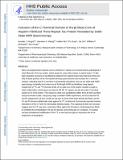| dc.contributor.author | Dregni, Aurelio J. | |
| dc.contributor.author | Wang, Harrison K. | |
| dc.contributor.author | Wu, Haifan | |
| dc.contributor.author | Duan, Pu | |
| dc.contributor.author | Jin, Jia | |
| dc.contributor.author | DeGrado, William F. | |
| dc.contributor.author | Hong, Mei | |
| dc.date.accessioned | 2022-06-13T19:02:28Z | |
| dc.date.available | 2022-03-09T14:35:15Z | |
| dc.date.available | 2022-06-13T19:02:28Z | |
| dc.date.issued | 2021-05 | |
| dc.identifier.issn | 0002-7863 | |
| dc.identifier.issn | 1520-5126 | |
| dc.identifier.uri | https://hdl.handle.net/1721.1/141076.2 | |
| dc.description.abstract | Many neurodegenerative diseases such as Alzheimer's disease are characterized by pathological β-sheet filaments of the tau protein, which spread in a prion-like manner in patient brains. To date, high-resolution structures of tau filaments obtained from patient brains show that the β-sheet core only includes portions of the microtubule-binding repeat domains and excludes the C-terminal residues, indicating that the C-terminus is dynamically disordered. Here, we use solid-state NMR spectroscopy to identify the β-sheet core of full-length 0N3R tau fibrillized using heparin. Assignment of 13C and 15N chemical shifts of the rigid core of the protein revealed a single predominant β-sheet conformation, which spans not only the R3, R4, R' repeats but also the entire C-terminal domain (CT) of the protein. This massive β-sheet core qualitatively differs from all other tau fibril structures known to date. Using long-range correlation NMR experiments, we found that the R3 and R4 repeats form a β-arch, similar to that seen in some of the brain-derived tau fibrils, but the R1 and R3 domains additionally stack against the CT, reminiscent of previously reported transient interactions of the CT with the microtubule-binding repeats. This expanded β-sheet core structure suggests that the CT may have a protective effect against the formation of pathological tau fibrils by shielding the amyloidogenic R3 and R4 domains, preventing side-on nucleation. Truncation and post-translational modification of the CT in vivo may thus play an important role in the progression of tauopathies. | en_US |
| dc.language.iso | en | |
| dc.publisher | American Chemical Society (ACS) | en_US |
| dc.relation.isversionof | http://dx.doi.org/10.1021/jacs.1c03314 | en_US |
| dc.rights | Creative Commons Attribution-Noncommercial-Share Alike | en_US |
| dc.rights.uri | http://creativecommons.org/licenses/by-nc-sa/4.0/ | en_US |
| dc.source | PMC | en_US |
| dc.title | Inclusion of the C-Terminal Domain in the β-Sheet Core of Heparin-Fibrillized Three-Repeat Tau Protein Revealed by Solid-State Nuclear Magnetic Resonance Spectroscopy | en_US |
| dc.type | Article | en_US |
| dc.identifier.citation | Dregni, Aurelio J, Wang, Harrison K, Wu, Haifan, Duan, Pu, Jin, Jia et al. 2021. "Inclusion of the C-Terminal Domain in the β-Sheet Core of Heparin-Fibrillized Three-Repeat Tau Protein Revealed by Solid-State Nuclear Magnetic Resonance Spectroscopy." Journal of the American Chemical Society, 143 (20). | en_US |
| dc.contributor.department | Massachusetts Institute of Technology. Department of Chemistry | |
| dc.relation.journal | Journal of the American Chemical Society | en_US |
| dc.eprint.version | Author's final manuscript | en_US |
| dc.type.uri | http://purl.org/eprint/type/JournalArticle | en_US |
| eprint.status | http://purl.org/eprint/status/PeerReviewed | en_US |
| dc.date.updated | 2022-03-09T14:26:25Z | |
| dspace.orderedauthors | Dregni, AJ; Wang, HK; Wu, H; Duan, P; Jin, J; DeGrado, WF; Hong, M | en_US |
| dspace.date.submission | 2022-03-09T14:26:27Z | |
| mit.journal.volume | 143 | en_US |
| mit.journal.issue | 20 | en_US |
| mit.license | OPEN_ACCESS_POLICY | |
| mit.metadata.status | Authority Work Needed | en_US |
